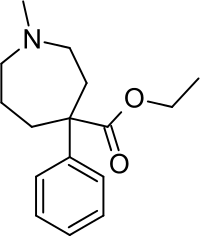Ethoheptazine
Ethoheptazine[1] (trade name Zactane) is an opioid analgesic from the phenazepane family. It was invented in the 1950s[2] and is related to other drugs such as proheptazine and pethidine.[3]
 | |
 | |
| Clinical data | |
|---|---|
| Trade names | Equagesic |
| Other names | Zactane |
| Routes of administration | Oral |
| ATC code |
|
| Legal status | |
| Legal status |
|
| Identifiers | |
| |
| CAS Number | |
| PubChem CID | |
| DrugBank | |
| ChemSpider | |
| UNII | |
| ChEMBL | |
| CompTox Dashboard (EPA) | |
| ECHA InfoCard | 100.000.917 |
| Chemical and physical data | |
| Formula | C16H23NO2 |
| Molar mass | 261.365 g·mol−1 |
| 3D model (JSmol) | |
| |
| |
| | |
Ethoheptazine produces similar effects to other opioids, including analgesia, sedation, dizziness and nausea.[4] It was sold by itself as Zactane, and is still available as a combination product with acetylsalicylic acid and meprobamate as Equagesic, which is used for the treatment of conditions where both pain and anxiety are present.[5] It was also investigated for use as an antitussive.[6]
It is no longer prescribed, as it is no longer FDA approved, and not available for United States' Pharmacy Processing. Revocation of FDA Approved Medications Status stems from a combination of efficacy vs. toxicity, and the more-varied and historically safer Benzodiazepines Class. Only reversal of the FDA's decision, allows removing the drug from the CSD. Ethoheptazine is not listed as a controlled substance under the Controlled Substances Act, 1970 in the United States.[7] The controlled status (Schedule IV) of Equagesic was due to the meprobamate content.[8][9] Regulation elsewhere varies.
References
- ES Patent 310184
- Batterman RC, Golbey M, Grossman AJ, Leifer P. Analgesic effectiveness of orally administered ethoheptazine in man. American Journal of the Medical Sciences. 1957 Oct;234(4):413-9.
- Diamond J, Bruce WF, Tyson FT. Synthesis and Properties of the Analgesic DL-α-1,3-dimethyl-4-phenyl-4-propionoxyazacycloheptane (Proheptazine). Journal of Medicinal Chemistry. 1964 Jan;7:57-60.
- Cinelli P, Zucchini M. Current pharmaco-therapeutic possibilities in the treatment of pain. Experiments with ethoeptazine. (Italian). Minerva Medica. 1962 Mar 3;53:637-42.
- Scheiner JJ, Richards DJ. Treatment of musculoskeletal pain and associated anxiety with an ethoheptazine-aspirin-meprobamate combination (equagesic): a controlled study. Current Therapeutic Research, Clinical and Experimental. 1974 Sep;16(9):928-36.
- J Pharmacol Exp Ther November 1979 211:401-408
- http://www.deadiversion.usdoj.gov/quotas/conv_factor/index.html
- PDR 1978, pp 1618
- http://www.deadiversion.usdoj.gov/quotas/conv_factor/index.html